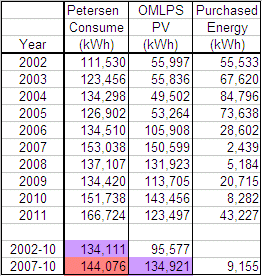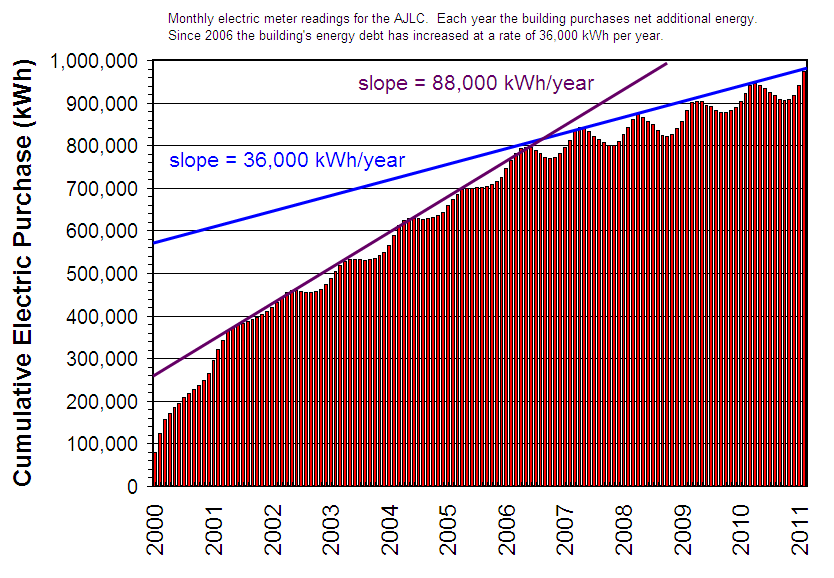Oberlin's Adam Joseph Lewis Center not a net-energy exporter, despite claims to the contrary.
John H. Scofield
In a recent article published in High Performance Buildings, John Petersen provides the scientific basis for the claim that Oberlin College's Adam Joseph Lewis Center (AJLC) is a net-energy exporter - that the building's annual photovoltaic energy production exceeds its annual energy consumption [1]. Earlier in 2007, only 10 months after the second PV array came on-line, Petersen predicted that the two PV arrays would annually generate 10% more energy than the building consumed [2]. The claim that the Lewis Center annually produces more energy than it consumes has appeared on the Oberlin College web site, in the Oberlin College Alumni Magazine, has been frequently repeated by College Administrators, faculty, students, and various news outlets, and is repeated by hundreds if not thousands of web sites. It is an important part of the sustainability cannon.
Sadly, the claim is not supported by the facts. Not only is the building not now a net-energy-exporter, the data show that, in its 11 year existence, there is not one year in which the AJLC has produced more energy than it consumed -- though it came close in 2007. Before 2006 several studies concluded that its 58-kW rooftop PV array produced less than half the building's annual energy [3, 4]. Since the 2006 installation of the second, 101-kW parking lot PV array, the combined PV arrays have failed to meet the building's annual energy needs. For the four years 2007-2010 the building has, on average consumed at least 9,000 kWh/year more than its PV Arrays produced. Data for 2011 show the energy deficit is greater than 40,000 kWh [5].
Annual AJLC energy -- consumed, generated, and purchased -- are shown in the graph and table below. Building energy consumption figures are those put forward by John Petersen, extracted from his web-based Building Energy Dashboard (http://www.oberlin.edu/ajlc/), selecting the Historic Data tab and choosing Custom Period for each year. Annual photovoltaic energy production data were obtained from Oberlin's municipal electric power company which has metered the AC energy exported to the building since 2001. As the data clearly show, building energy consumption exceeded PV production in every year since the building was constructed.
 |
 |
How then
do we understand Petersen's claim put forward in his High Performance
Buildings' article? The claim is based on an apples-to-oranges comparison,
an all-too-familiar methodology employed in the green building community
[6, 7]. Petersen
compares the average annual building energy consumption for the period
2002-2010 to the average annual energy production for the period 2007-2010.
These averages are highlighted in purple in the table above. Petersen
subtracts the 2007-2010 PV production average (134,921 kWh) from the
2001-2010 consumption average
(134,111 kWh) and obtains a negative annual site energy. The intent
clearly is to demonstrate that the building produces more energy than
it consumes, making it a net-energy exporter [8].
The conclusion is mathematically correct but scientifically irrelevant.
Imagine if a business attempted to prove it was operating in the black
by demonstrating this year's revenue exceeded last year's expenses!
The spin is clever -- but the science is wanting. As the above graph
clearly shows, the building's energy consumption has increased over
the years. Hence the average annual energy consumed by the building
for the nine year period 2002-2010 is lower than the average annually
consumed since the second PV array was installed in 2006.
The correct "apples-to-apples" comparison, of course, is the 2007-10 average energy consumption (144,076 kWh) to the 2007-10 average energy production (134,921 kWh) which shows that the building, on average, continues to import 9,200 kWh of grid energy each year. And, as the data for 2011 show, the "trade deficit" is growing. A zero energy building is one that, on an ongoing basis, generates more energy annually than it consumes. It is not one that generates more energy now than it once consumed some time in the past.
Given the 2001-2005 enegy consumption figures for the AJLC and the projected output of its soon-to-be-installed 101-kW parking lot PV array, everyone (including me) believed the energy soon to be provided by the second PV array would make the AJLC a net energy exporter. Why was this not accomplished? There are two reasons. First, the new array has not produced the expected 100,000 kWh per year and has under-performed by about 20%.
Secondly, building energy consumption has steadily risen. Like all buildings, continued expansion of occupant's use of technology leads to larger plug loads. But the biggest contributor to energy consumption has been the poor performance of the geothermal heating system. The well field is under-sized, the building's winter heating and summer cooling are out of balance, and many of its 30-or-so heat pumps are not designed for ground-source operation -- meaning they cannot supply sufficient heat when the ground water temperature falls below 40 deg-F. A large electric boiler remains in the building to supply the heat pumps with warmer water when the ground temperature drops below this threshold. (For an extensive discussion of the mechanical design flaws of this building see my 2002 ASHRAE article.) For the last two winters this building has been heated largely by electricity, not the ground. No doubt Mr. Petersen's extensive energy monitoring system has measured this continuously. Apparently, not all monitoring leads to improved building performance.
Readers who have followed the history of this building and my comments on its design will recall that I used to measure building energy consumption using a second OMLPS electric meter outside the AJLC. Why then, you might ask, do I now rely upon John Petersen's energy consumption data (obtained from Dashboard) instead of the OMLPS building electric meter that used to provide these data?
The answer is as follows. In 2006 (or 2005?), when the AJLC Annex (132 Elm Street) was renovated, the decision was made to disconnect the annex from its old, metered electric feed, and to, instead, feed it electricity from the secondary of the AJLC transformer -- without metering the feed. That is, the OMLPS meter I used to rely on now measures the electricity used by two buildings - the AJLC and the AJLC Annex. Data from this meter are graphed below.

The graph clearly shows that the AJLC Complex (the two combined buildings) have imported an average of 36,000 kWh of electricity per year since 2006. College billing records show that the College purchased 31,000, 30,000, 57,000 kWh, 38,000 kWh, and 70,000 kWh for the AJLC complex for 2007, 2008, 2009, 2010, and 2011 (respectively).
Because the electric feed to the AJLC Annex is unmetered no one other than Mr. Petersen knows how much energy is used by the AJLC. It is a curious thing that Mr. Petersen, who has metered the electric use of dozens of campus buildings, including several academic buildings, has little interest in monitoring the electric use of 132 Elm St. which houses his operation. The College is in the process of metering 132 Elm St.
Note that it is inconceivable that 132 Elm St. uses as much as 36,000 kWh of electric energy per year. More likely it has an annual use of 12,000 - 18,000 based on usage by similar houses. About 9,000 kWh per year are lost in the Lewis Center's grid transformer, and the rest provides the AJLC with the energy it cannot provide itself.
To summarize I find that, despite numerous claims to the contrary, Oberlin College's Adam Joseph Lewis Center for Environmental Studies does not generate all of its energy renewably and is not achieved net-zero energy status. The High Performance Buildings paper that presents the case that the building has net negative site energy intensity arrives at this conclusion through specious reasoning, offering clever spin rather than sound scientific reasoning.
============================================
1. John Petersen, "Early Adopter: Case Study for Oberlin College's Adam Joseph Lewis Center for Environmental Studies," High Peformance Buildings (ASHRAE, Winter 2011).
2. J. E. Petersen, "Production and consumption of electricity in Oberlin College's Lewis Center for Environmental Studies: realizing the goal of a net zero building," Proceedings of the American Solar Energy Society (Cleveland, OH, 2007).
3. J. H. Scofield, "Early energy performance for a green academic building," ASHRAE Transactions, vol. 108, part 2, 1214-1230 (2002).
4. S.Pless and P. Torcellini, "Energy performance evaluation of a low-energy academic building," Conference Paper, NREL/CP-550-38962 (October 2005)
5. The 9,000 kWh/year import average is based on Petersen's building energy consumption data. We know he does not account for the estimated 8,000-10,000 kWh annual losses in the building transformer. The power company's billing meter suggests net import of energy as high as 36,000 kWh per year, depending on the amount annually used by an adjacent house. There is reason to believe Petersen has also omitted energy consumed by in the parking pavilion that supplies much of the building's PV energy from his energy consumption figure.
6. Henry Gifford and others have pointed out that the NBI study of LEED-certified buildings compared the median site energy intensity of LEED buildings to the mean for all US buildings, skewing the comparison.
7. J. H. Scofield, "A re-examination of the NBI LEED Building Energy Consumption Study," Proceedings of the International Energy Program Evaluation Conference (IEPEC), August 12-14, 2009, Portland, OR.
8. Petersen presents energy figures in terms of annual site energy intensity in units kBtu/sf/year. The kWh figures I have provided here are in agreement with his site energy intensity figures once converted to Btu's (1 kWh = 3,416 Btu) and divided by the the 13,600 sf building area.
9. Prior to April 27, 2011 the Dashboard displayed Rooftop Solar and Parking Lot Solar figures that were consistent with OMLPS measurements, but also displayed the undefined quantity Solar Produced that was 10% larger than the sum of the two arrays. The web site was arranged so that a visitor naturally compared Solar Produced with Total Electricity Consumed and concluded that energy production met or exceeded consumption, even though the sum of the enegies produced by the two arrays was less than the energy consumed. I pressed Mr. Petersen to explain this quantity "Solar Produced." He was lothe to do so and, with pressure from the Oberlin College administration, Petersen removed the Solar Produced figure from Dashboard and replaced it with a quantity called PV Production which was equal to the sum of the two arrays and consistent with OMLPS measurements. These numbers remained posted on Dashboard until late September when they again changed.